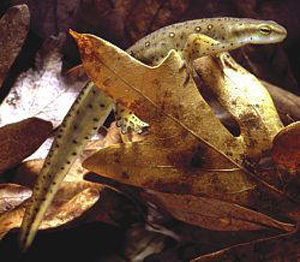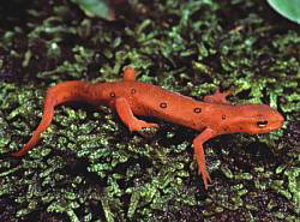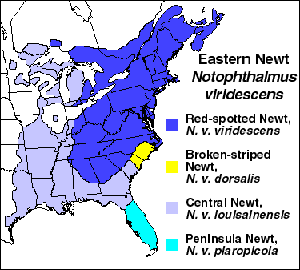Red Spotted Newt - Notophthalmus viridescens
The Red-spotted newt is one of the most popular pet newts in the United States. Like most newts, they are relatively easy to keep in captivity, provided that you can acquire a steady supply of small vertebrates and invertebrates for them to eat.

The Red-Spotted Newt gets its name from the many red spots that occur on its dorsal surface against the background color of brown to olive green in adults. The red spotted newt undergoes two metamorphoses. The first is the usual transformation from aquatic, gilled larva to an air-breathing terrestrial form, a sexually immature land phase called an Eft. Sometimes the eft stage is skipped completely and they go directly from the larval to the adult aquatic stage. The second metamorphosis is to a breeding aquatic adult Newts.
This is a rather easy pet to care for and enjoy since they are typically active animals. All newts have toxic skin secretions.
Average Size - Efts usually reach only about 3 inches. Adults reach lengths of nearly 5 inches
Life Span - The Eft stage may last anywhere from 1-7 years. Adult stage can last as long
Diet - Red efts eat waxworms, flightless fruit flies and pin-head crickets. They will also eat very small earthworms. Adults will eat earthworms and are fairly good for them. Crickets are also accepted by newts as well, but make sure they're not too big. Brine shrimp and ghost shrimp are common prey items and can be bought in your local pet shop. Newts will also eat strips of raw beef and hamburger – just don’t feed too often. Bloodworms, whiteworms, tubifex worms, and guppies and other small fish are also potential feeder items. - learn "how to raise feeder foods"
Feeding - Red spotted newts do not have to be fed every day - every other day or every three days is often enough. It may take a little experimentation to figure out how much and how often they should be fed, but you can try to judge by their growth and body condition (fat or skinny) and whether excess food is being left (which will cause toxins to build up in the tank).
Housing - Up to three efts or adults can be kept adequately in a ten gallon tank. A 20 gallon tank will hold 4-8 animals, and 10-12 can be kept in a 30 gallon aquarium. Newts, like other herps, will gladly wonder off if given the chance, so your cage will need a secure top.
Substrate - For efts, all you need is a damp terrarium containing a large water dish that is easily accessible. Soil will hold the moisture very well, this also allows you to add live plants in the cage. Also add a hide spot or  two where the efts can go to feel secure. As for newts, gravel is best. Gravel can be purchased from most pet shops, and comes in a variety of colors. To create a land area in the aquatic setup, there's nothing easier than large rocks. two where the efts can go to feel secure. As for newts, gravel is best. Gravel can be purchased from most pet shops, and comes in a variety of colors. To create a land area in the aquatic setup, there's nothing easier than large rocks.
Habitat - For efts - imitate their natural environment - damp woodland "floor". Soil for the substrate, moss is good to hold moisture and even out humidity. A hide box is impotant for the erft to go and feel secure. For adults mainly an aquatic environment but as mentioned add an area of land - large rocks that sick out of the water will do just fine. Filtration should be provided, although strong currents are best avoided. Inside corner filters (the kind powered by air) work well, as they create little current. Internal power filters are also a good choice, as long as they are not too powerful and positioned so as to minimize the current produced. Under gravel filters are also a good option.
Recommended Supplies:
- Habitat with secure lid
- Thermometer
- Light timer
- Filter
|
- Substrate
- Driftwood
- Incandescent light or ceramic heater
|
Habitat Maintenance - Approximately 1/3 of the volume of water in the tank should be removed and replaced with fresh, dechlorinated water every 1-2 weeks (depending on the size of the tank and the number of newts - it should be done more often for smaller tanks and larger numbers of newts). A gravel washer is an inexpensive tool available at pet stores that allows the gravel to be gently agitated and cleaned while siphoning off water. For efts, check soil, if it smells, has funfus or mold etc - replace
Grooming and Hygiene - When cleaning housing, check newt for any abrasions, signs of parasites or or fungal infections. Always wash your hands before and after touching your newt or habitat contents to help prevent Salmonella and other infectious diseases.
Breeding Tips: Mating begins in the spring or the autumn, in shallow pools and ponds. The males grab the females from above, either around the chest or the neck, and will hover above them for what could be up to a few hours, then will suddenly drop a spermatophore and leave a moment later. The females lay their eggs in spring, and the clutch count is somewhere around 250 eggs. The larvae only need three or four weeks to hatch, and then normally metamorphose some 12 to 13 weeks 
Rearing Larvae - The larvae are carnivorous from the time they have absorbed their yolk, a few days after hatching. From then on, it is necessary to provide them with live food. Good foods are Cyclops and baby Daphnia. Cyclops can often be unknowingly cultivated in aquatic setups- the parents' tank may contain some which can be used to feed the young larvae. As the larvae grow, they will take larger Daphnia, whiteworm, and bloodworm. Some people have have success feeding them on non-live food, using frozen bloodworm or even fish pellets. It is critical to provide enough food - larvae should be fed daily where possible, though adults may be fed only twice a week. Large larvae are extremely voracious, and will attack each other if underfed or overcrowded.
Metamorphosis - Metamorphosis to the eft stage takes place within 12 -13 weeks, depending on food supply and temperature, at a size of 5-8 cm (2-3 inches). Efts need to leave the water, in order to prevent drowning. Young newts can eat very large quantities of food, and if fed sufficiently, may grow to adult size in one year. Two years is a more common time to reach adult size in captivity.
Temperature - Perhaps the most convenient part of newt keeping is the fact that virtually all species can be kept at room temperature or even cooler. No special heating is required. The ideal temperature for newts is about 60 – 65 degrees F. In the spring when the breeding season rolls around, you will have to raise the temperature a bit, which can be done naturally if you live in an area where the seasons are well defined. Otherwise you can use a submersible heater. If you wish to hibernate keep them at about 40 degrees Fahrenheit for a few weeks and them warm them up slowly when you re ready to bring them back out – this can also help facilitate breeding.
Lighting - Red spotted newts do not need of full spectrum lighting, regular lighting is appropriate.
Humidity - Keep red efts in a somewhat humid environment. Humidity levels of 60 – 70% are fine. Misting several times a day and fully soaking plants and substrate should provide enough humidity. Watch for fungus, molds, etc. – these should not be allowed to stay.
Signs of a Healthy Pet:
- Clear eyes
- Clear nose and mouth
- Active and alert
|
- Eats regularly
- Healthy skin
|
Common Health Issues and Red Flags:
- Vomiting
- Discharge in nose or mouth
- Lethargy
|
- Abnormal feces
- Decreased appetite
- Cloudy eyes
| As with all pets in this category, it is important that you find a veterinarian that practices in EXOTICS – this is critical. The typical small animal practitioner may not have sufficient knowledge in this area.
Even this guide is general in nature and should not be used to diagnose your pet.
|



 two where the efts can go to feel secure. As for newts, gravel is best. Gravel can be purchased from most pet shops, and comes in a variety of colors. To create a land area in the aquatic setup, there's nothing easier than large rocks.
two where the efts can go to feel secure. As for newts, gravel is best. Gravel can be purchased from most pet shops, and comes in a variety of colors. To create a land area in the aquatic setup, there's nothing easier than large rocks. 